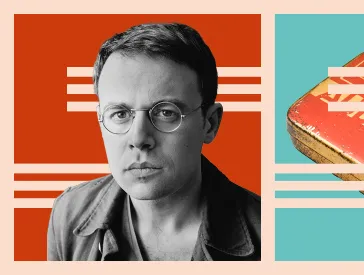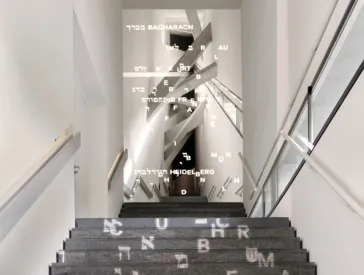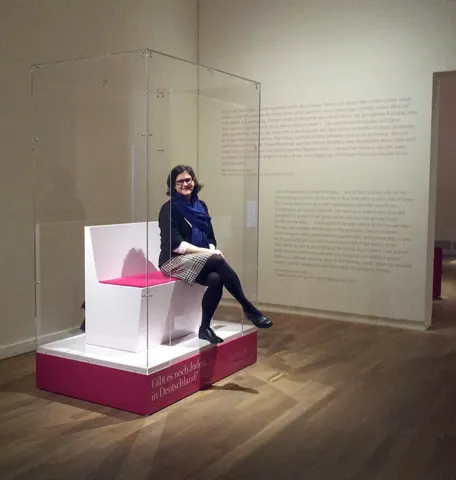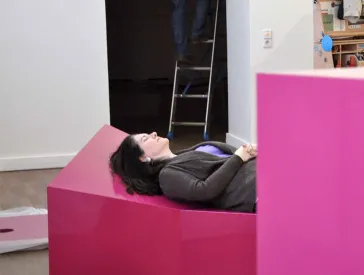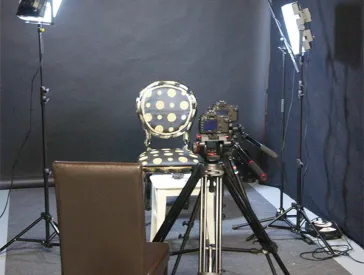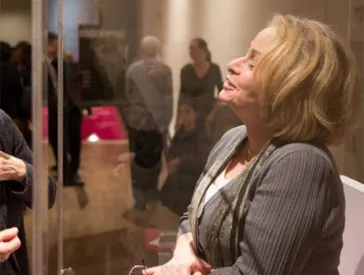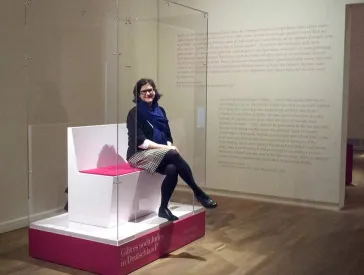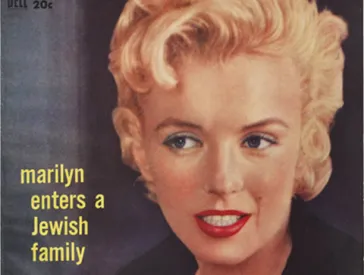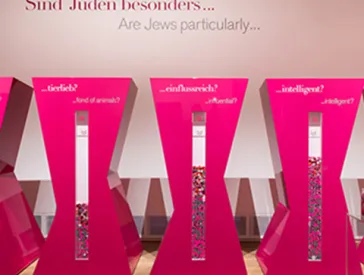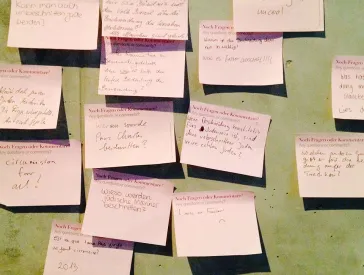Von Wagner bis zum Wetter
Meine zwei Stunden als lebendiges Ausstellungsstück in der Ausstellung „Die ganze Wahrheit“
Das war eine wahrlich außergewöhnliche Erfahrung. Die besten Momente waren die, als die Besucher*innen nicht nur mit mir in der Vitrine, sondern untereinander zu reden anfingen. Diese Gespräch führten dann von Wagner bis zum Wetter und kreisten nicht ‚nur‘ darum, wie es sich anfühlt, in Deutschland jüdisch – in meinem Fall als Tochter einer amerikanischen Jüdin und eines deutschen, ehemals evangelischen Vaters – aufgewachsen zu sein, und ob es nicht merkwürdig ist, in so einer Glasvitrine zu sitzen.
Ich musste plötzlich an meinen Abschied aus New York denken, als ich 1998 nach Deutschland zurückkehrte (obwohl ich mir das damals nicht so eingestehen wollte). Mein Chef, ein deutscher Verleger in New York, war gerade vom neugewählten Kanzler zum ersten deutschen Staatsminister für Kultur ernannt worden, und er hatte mir angeboten, im Kanzleramt weiter für ihn zu arbeiten, erst in Bonn, dann in Berlin. Beim Abschiedsumtrunk im Verlag, also, grinste ein Lektor: „Na, in der deutschen Regierung zu arbeiten, das ist ja der perfekte Job für eine brave kleine Jüdin!“ Ich dachte darüber nach und sagte: „Genau.“
So kam ich dann auf Umwegen ins Jüdische Museum Berlin, wo ich seit zwölf Jahren arbeite, und – an einem scheinbar ruhigen Montagmittag – letztendlich auch in diese Vitrine. In meinen zwei Stunden als lebendiges Ausstellungsstück …
... wurde ich gefragt:
Von einer deutschen Besucherin: „Ist es im Judentum Pflicht, regelmäßig am Gottesdienst in der Synagoge teilzunehmen?“
Von einer französischen Dame: „Meinen Sie nicht auch, dass es ein großer Fehler war, dass die Alliierten (sic!) nach dem Zweiten Weltkrieg den Staat Israel gegründet haben?“
Von einem deutschen Studenten: „Ist es richtig, dass die Juden keine Belohnung in einem Leben nach dem Tod erwarten, sondern sich in ihrem Handeln auf das Diesseits konzentrieren?“
Von einem Amerikaner, der mich laut und mit starkem amerikanischem Akzent ansprach, auch nachdem ich ihm auf Englisch geantwortet hatte (offensichtlich wandte er sich an ein größeres – wenn auch größtenteils imaginäres – Publikum): „Schämen Sie sich nicht, in dieser Box zu sitzen? Müssen die armen, armen Deutschen sich jetzt von den Juden auch noch das Judentum erklären lassen? Ist das wirklich unser Job?“
Von zwei älteren deutschen Damen: „Das ist ja alles schön und gut, aber ist Ihr Sohn beschnitten?“
... durfte ich an verschiedenen Unterhaltungen teilhaben, die aus dieser merkwürdigen Konstellation mit der Vitrine erwuchsen:
Ein amerikanischer Gentleman alter Schule, dessen Eltern um die vorige Jahrhundertwende vor den Pogromen des Zaren aus Kiew in die USA flüchteten, fragte eine Bremer Lehrerin nach ihrer Kindheit. Ihr Vater war ein einfacher Tischler mit wenig Schulbildung gewesen, erzählte sie uns. Er weigerte sich, in die NSDAP einzutreten, und daraus seien ihm keine besonderen Nachteile erwachsen. Beide Eltern hätten ihrer Tochter (Jahrgang 1941) gegenüber immer wieder beteuert, dass diejenigen Deutschen, die die Nazis unterstützt hatten, es aus völlig freien Stücken getan hatten, ob aus Überzeugung oder Opportunismus – auch wenn sie es nach dem Krieg gerne anders darstellten.
Eine Gruppe von Deutschen um die zwanzig sprach mit einem israelischen Ehepaar Mitte dreißig, das zum ersten Mal in Deutschland und Berlin war. Ursprünglich hatten sie ein romantisches Wochenende geplant, weil sie so viel von Berlin gehört hatten, meinte die Frau mit steinernem Gesicht. Aber jetzt fühle sie sich ständig unwohl, sie können es nicht ertragen, auf der Straße Deutsch zu hören, vor allem in den Bahnhöfen, die deutschen Stimmen über die Lautsprecher. Sie wisse, dass das unfair und irrational sei, aber sie habe Alpträume, und könne den Rückflug kaum erwarten. „Wie hält man es aus, hier zu leben?“
Ein Rabbiner aus New Jersey erzählte uns von seinen zwei Geburtsurkunden: Ende der 1960er Jahre im Münchner Stützpunkt der US-Armee geboren, steht in der ersten „Religion: Evangelisch“. Als sich sein Vater, ein Militärgeistlicher, beschwerte, bekam er eine zweite ausgehändigt: „Religion: Mosaisch“. Es sei ihnen unmöglich, erklärten die Beamten dazu, das Wort ‚Jüdisch‘ oder gar ‚Jude‘ auf ein offizielles Dokument zu schreiben.
Eine schüchterne, ältere Frau aus Dresden lächelte mich freundlich an und antwortete, als ich mich zum Gespräch anbot: „Wissen Sie, ich habe ganz viele Fragen, aber keine, bei denen Sie mir helfen könnten. Ich bin voller Fragen an meine Eltern – die waren eifrige, überzeugte Nazis. Jetzt sind sie schon lange tot, und als ich noch die Möglichkeit gehabt hätte, habe ich sie nie gefragt.“ Ihre Augen füllten sich mit Tränen, und meine auch, aber dann legte sie mir die Hand auf den Arm und sagte: „Danke, dass sie hier sitzen, in diesem Jüdischen Museum.“
Und, in einem dieser sinnig sinnlosen Zufälle, die man einfach nur feststellen kann, traf ich um 14:30 Uhr ein über achtzigjähriges Ehepaar aus San Francisco, das hier in Berlin war, um den Ring in der Staatsoper zu sehen (ihren fünften kompletten Ring); und um 15:15 Uhr kam eine junge Sängerin von der Upper West Side in New York mit ihren Eltern an meiner Vitrine vorbei, die gerade vor ein paar Tagen im Parsifal an der Deutschen Oper gesungen hatte.
... und schließlich habe ich eine Sache gelernt:
Eine jüdische Mutter fragt ihr Kind nach der Schule nicht: „Was hast Du heute gelernt?“, sondern: „Welche Fragen hast Du heute gestellt?“
Das muss ich mir merken, für die Zeit, wenn meine Töchter und mein (unbeschnittener!) Sohn in die Schule kommen.
Signe Rossbach, Kuratorin für Veranstaltungen
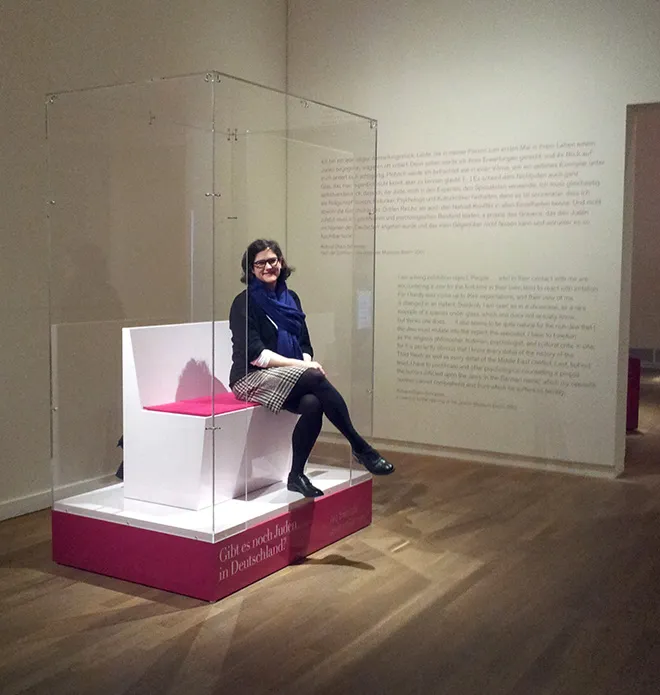 X
X
Signe Rossbach in der Ausstellung Die ganze Wahrheit, 8. April 2013; Jüdisches Museum Berlin, Foto: Michal Friedlander
Zitierempfehlung:
Signe Rossbach (2013), Von Wagner bis zum Wetter. Meine zwei Stunden als lebendiges Ausstellungsstück in der Ausstellung „Die ganze Wahrheit“.
URL: www.jmberlin.de/node/6417
Blick hinter die Kulissen: Beiträge zur Ausstellung „Die ganze Wahrheit“ (7)
